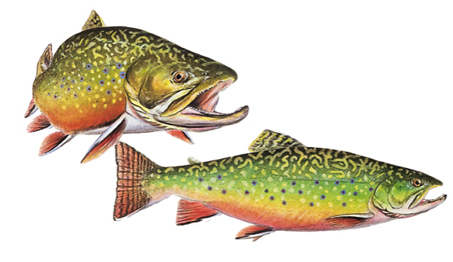The brook trout’s body is trout-like and may be confused with the lake trout. Brook trout have square tails, light worm-like markings and spots, red and blue, on a dark background. Also, there is a white leading edge on the lower fins that is accented by a black line.
Common Names: Brook trout, speckled trout, speckled char
Habitat
Brook trout are found across most parts of the province in cold, clear streams and small lakes. During summer months if water temperatures rise too high in local streams, fish will move down stream to larger parts of the river or even completely out of the stream and into the lake. Where available, brook trout tend to inhabit depths between 15-30 feet in the summer months.
Spawning Patterns
Spawning occurs in the fall months, as early as August in the far north to as late as December in the southern portion of their range. Spawning occurs in the gravelly headwaters of rivers and streams, but they will spawn in open water areas if suitable locations, such as upwellings, are available. Very small streams entering lakes can provide important spawning and nursery habitat. Because of the large egg size, a female produces significantly less eggs than many other species of fish, with the maximum number of eggs being around 5,000.
Diet
The favourite foods of brook trout include such things as worms, leeches, aquatic insects and many species of fish. Brook trout are known to be cannibalistic during the fall when they tend to prey on their own eggs and in the spring when they may consume their own young.
Age and Size
Brook trout are a short-lived fish species with the maximum age typically being around five, and seldom does a brook trout live longer than eight years. The growth of brook trout can be dependant on the number of fish present in the local area; lakes or streams with high numbers of fish tend to have stunted populations. Fish over five pounds are considered trophies but are relatively common catches.
Fishing Tips
Brook trout are a short-lived fish species with the maximum age typically being around five, and seldom does a brook trout live longer than eight years. The growth of brook trout can be dependant on the number of fish present in the local area; lakes or streams with high numbers of fish tend to have stunted populations. Fish over five pounds are considered trophies but are relatively common catches.
Fish illustration ©CURTIS ATWATER (www.natureartists.com/atwaterc.htm)










